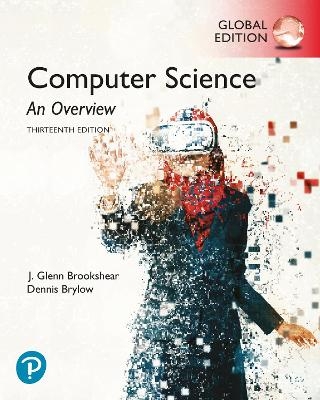
Computer Science: An Overview, Global Edition
Pearson Education Limited (Verlag)
978-1-292-26342-7 (ISBN)
Computer Science: An Overview provides a bottom-up, concrete-to-abstract foundation that students can build upon to see the relevance and interrelationships of future computer science courses. Its comprehensive coverage and clear language are accessible to students from all backgrounds, encouraging a practical and realistic understanding.
More than 1,000 questions and exercises, Chapter Review Problems, and Social Issues questions reinforce core concepts.
The 13th Edition continues its focus on Python to provide programming tools for exploration and experimentation. A new full-color design reflects the use of color in most modern programming interfaces to aid the programmer’s understanding of code. Syntax coloring is now used more effectively for clarifying code and pseudocode segments in the text, and many figures and diagrams are now rendered more descriptively.
* Asterisks indicate suggestions for optional sections.
0. Introduction
0.1 The Role of Algorithms
0.2 The History of Computing
0.3 An Outline of Our Study
0.4 The Overarching Themes of Computer Science
1. Data Storage
1.1 Bits and Their Storage
1.2 Main Memory
1.3 Mass Storage
1.4 Representing Information as Bit Patterns
*1.5 The Binary System
*1.6 Storing Integers
*1.7 Storing Fractions
*1.8 Data and Programming
*1.9 Data Compression
*1.10 Communication Errors
2. Data Manipulation
2.1 Computer Architecture
2.2 Machine Language
2.3 Program Execution
*2.4 Arithmetic/Logic Instructions
*2.5 Communicating with Other Devices
*2.6 Programming Data Manipulation
*2.7 Other Architectures
3. Operating Systems
3.1 The History of Operating Systems
3.2 Operating System Architecture
3.3 Coordinating the Machine's Activities
*3.4 Handling Competition Among Processes
3.5 Security
4. Networking and the Internet
4.1 Network Fundamentals
4.2 The Internet
4.3 The World Wide Web
*4.4 Internet Protocols
*4.5 Simple Client Server
4.6 Cybersecurity
5. Algorithms
5.1 The Concept of an Algorithm
5.2 Algorithm Representation
5.3 Algorithm Discovery
5.4 Iterative Structures
5.5 Recursive Structures
5.6 Efficiency and Correctness
6. Programming Languages
6.1 Historical Perspective
6.2 Traditional Programming Concepts
6.3 Procedural Units
6.4 Language Implementation
6.5 Object-Oriented Programming
*6.6 Programming Concurrent Activities
*6.7 Declarative Programming
7. Software Engineering
7.1 The Software Engineering Discipline
7.2 The Software Life Cycle
7.3 Software Engineering Methodologies
7.4 Modularity
7.5 Tools of the Trade
7.6 Quality Assurance
7.7 Documentation
7.8 The Human-Machine Interface
7.9 Software Ownership and Liability
8. Data Abstractions
8.1 Basic Data Structures
8.2 Related Concepts
8.3 Implementing Data Structures
8.4 A Short Case Study
8.5 Customized Data Types
8.6 Classes and Objects
*8.7 Pointers in Machine Language
9. Database Systems
9.1 Database Fundamentals
9.2 The Relational Model
*9.3 Object-Oriented Databases
*9.4 Maintaining Database Integrity
*9.5 Traditional File Structures
9.6 Data Mining
9.7 Social Impact of Database Technology
10. Computer Graphics
10.1 The Scope of Computer Graphics
10.2 Overview of 3D Graphics
10.3 Modeling
10.4 Rendering
*10.5 Dealing with Global Lighting
10.6 Animation
11. Artificial Intelligence
11.1 Intelligence and Machines
11.2 Perception
11.3 Reasoning
11.4 Additional Areas of Research
11.5 Artificial Neural Networks
11.6 Robotics
11.7 Considering the Consequences
12. Theory of Computation
12.1 Functions and Their Computation
12.2 Turing Machines
12.3 Universal Programming Languages
12.4 A Noncomputable Function
12.5 Complexity of Problems
*12.6 Public-Key Cryptography
Appendixes:
A. ASCII
B. Circuits to Manipulate Two's Complement Representations
C. Vole: A Simple Machine Language
D. High-Level Programming Languages
E. The Equivalence of Iterative and Recursive Structures
F. Answers to Questions & Exercises
Index
| Erscheinungsdatum | 28.02.2019 |
|---|---|
| Verlagsort | Harlow |
| Sprache | englisch |
| Maße | 205 x 255 mm |
| Gewicht | 1234 g |
| Themenwelt | Mathematik / Informatik ► Informatik ► Theorie / Studium |
| Schlagworte | Computer Science • Grundlagen • Informatikstudium • Lehrbuch |
| ISBN-10 | 1-292-26342-3 / 1292263423 |
| ISBN-13 | 978-1-292-26342-7 / 9781292263427 |
| Zustand | Neuware |
| Haben Sie eine Frage zum Produkt? |
aus dem Bereich


